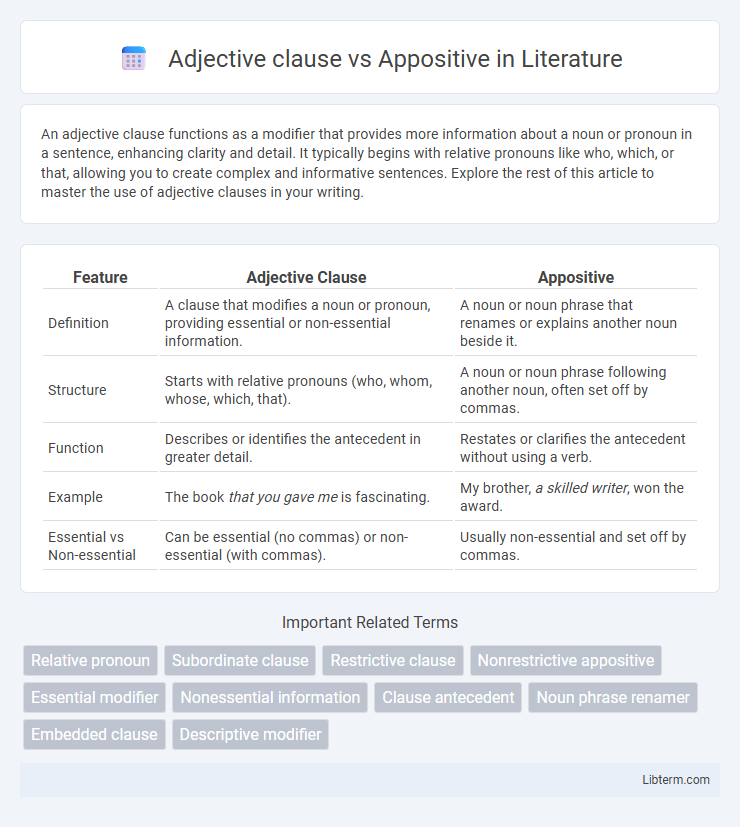An adjective clause functions as a modifier that provides more information about a noun or pronoun in a sentence, enhancing clarity and detail. It typically begins with relative pronouns like who, which, or that, allowing you to create complex and informative sentences. Explore the rest of this article to master the use of adjective clauses in your writing.
Table of Comparison
| Feature | Adjective Clause | Appositive |
|---|---|---|
| Definition | A clause that modifies a noun or pronoun, providing essential or non-essential information. | A noun or noun phrase that renames or explains another noun beside it. |
| Structure | Starts with relative pronouns (who, whom, whose, which, that). | A noun or noun phrase following another noun, often set off by commas. |
| Function | Describes or identifies the antecedent in greater detail. | Restates or clarifies the antecedent without using a verb. |
| Example | The book that you gave me is fascinating. | My brother, a skilled writer, won the award. |
| Essential vs Non-essential | Can be essential (no commas) or non-essential (with commas). | Usually non-essential and set off by commas. |
Introduction to Adjective Clauses and Appositives
Adjective clauses, also known as relative clauses, modify nouns by providing essential or non-essential information using relative pronouns like "who," "which," or "that." Appositives are noun phrases placed next to another noun to rename or clarify it, often set off by commas when non-essential. Understanding the distinction between adjective clauses and appositives is crucial for clear sentence structure and effective modification of nouns.
Definition of Adjective Clause
An adjective clause is a dependent clause that modifies a noun or pronoun by providing essential or non-essential information, often introduced by relative pronouns such as "who," "which," or "that." Unlike appositives, which are noun phrases that rename or explain a noun, adjective clauses function as modifiers to add descriptive details. Understanding the definition and use of adjective clauses is crucial for constructing complex and precise sentences in English grammar.
Definition of Appositive
An appositive is a noun or noun phrase that renames or provides additional information about a nearby noun, enhancing clarity and detail. Unlike an adjective clause, which modifies a noun by describing it using a relative pronoun and verb, an appositive functions as a standalone renaming element, often set off by commas. Appositives contribute to concise writing by embedding essential or non-essential information directly within the sentence structure.
Structure of Adjective Clauses
Adjective clauses, also known as relative clauses, typically begin with relative pronouns such as "who," "which," or "that" and function to modify a noun by providing essential or non-essential information. These clauses follow the noun they describe and contain both a subject and a verb, allowing them to act like adjectives within a sentence. In contrast, appositives are noun phrases that rename or clarify another noun without containing a subject-verb structure, and they are often set off by commas.
Structure of Appositives
Appositives are noun phrases that rename or clarify another noun, typically positioned directly after the noun they modify and set off by commas when non-restrictive. Unlike adjective clauses, which use relative pronouns like "who" or "which" to provide descriptive detail, appositives function as nouns providing equivalent information in a more compact form. The structure of appositives often involves a simple noun or noun phrase immediately following the main noun, such as in "My brother, a skilled guitarist, plays in a band.
Functions in a Sentence
Adjective clauses function to modify nouns or pronouns by providing essential or non-essential information, often introduced by relative pronouns like "who," "which," or "that." Appositives serve to rename or clarify a noun, typically placed directly after the noun they explain and often set off by commas. Both structures add descriptive detail, but adjective clauses act as modifiers while appositives function as noun phrases that provide identification or clarification.
Key Differences Between Adjective Clauses and Appositives
Adjective clauses provide essential or non-essential information about a noun and usually begin with relative pronouns such as who, which, or that, functioning as modifiers within sentences. Appositives rename or clarify a noun by placing a noun or noun phrase immediately after it, often set off by commas, serving as a brief explanation or identification. The key difference lies in adjective clauses containing verbs and offering descriptive detail, whereas appositives act as noun equivalents that restate or define the noun without additional verb phrases.
Common Examples and Usage
Adjective clauses, also known as relative clauses, modify nouns by providing essential or non-essential information, often beginning with relative pronouns like "who," "which," or "that," as in "The book that you borrowed is on the table." In contrast, appositives rename or clarify a noun and are typically set off by commas, such as in "My brother, a skilled guitarist, plays in a band." Both structures enhance sentences by adding detail, but adjective clauses function as modifiers, whereas appositives act as noun phrases that restate or elaborate the subject.
Tips for Correct Usage
Adjective clauses modify nouns by providing essential or non-essential information using relative pronouns like "who," "which," or "that," ensuring clarity and avoiding sentence fragments. Appositives rename or explain a noun immediately beside it, often set off by commas when non-restrictive, and should be concise to prevent redundancy. Correct usage involves identifying whether the added information defines the noun (use adjective clause) or simply renames it (use appositive), maintaining sentence flow and meaning precision.
Practice Exercises and Quiz
Practice exercises for adjective clauses often involve identifying the clause that modifies a noun and completing sentences by adding descriptive information to enhance clarity and detail. Quizzes on appositives typically require recognizing or inserting noun phrases that rename or explain the preceding noun, reinforcing understanding of sentence structure and meaning. Combining both types of practice strengthens grammar skills by highlighting the differences in function and form between adjective clauses and appositives.
Adjective clause Infographic

 libterm.com
libterm.com